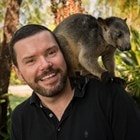Kunbarrasaurus is Australia’s new armoured dinosaur

John Pickrell
John Pickrell

IN 1989 A remarkably well-preserved dinosaur skeleton was found on an outback station near Richmond in north-western Queensland.
With more than 95 per cent of its bones, it was a spectacular specimen – one of the most complete armoured ankylosaurs ever found, and by far the most complete dinosaur from Australia, where dinosaur remains are typically in scrappy condition.
In 1996, Dr Ralph Molnar at the Queensland Museum provisionally assigned the specimen as an existing kind of ankylosaur – Minmi, known from Roma in the south-west of the state – but the plan was always to study the fossil in more detail.
Most existing reconstructions and illustrations of Minmi (such as the one above) have been based on this very complete fossil from Richmond. But the results of the detailed analysis are finally in, and they show that this animal isn’t Minmi at all, says Dr Steve Salisbury of the University of Queensland, a co-author of a new paper published today in the journal PeerJ.
Dinosaur lived around the Eromanga Sea
The Richmond specimen is different enough in the bones it shares with the original Minmi fossil for the researchers to name it as a new kind of ankylosaur, Kunbarrasaurus ieversi. The animal lived around Australia’s Eromanga Sea around 101-103 million years ago.
“Kunbarra is the word for ‘shield’ in the Mayi language of the Wunumara [Aboriginal] people from the Richmond area, and the species name honours the person who originally found the fossil, Mr Ian Ievers. It means ‘Ievers’ shield lizard’,” says study co-author Lucy Leahey, a PhD student in Steve’s research group at the University of Queensland.
The researchers came to their assessment by preparing part of the fossil at the Denver Museum of Nature and Science in the USA, and CT scanning the head in detail at the Mater Adult Hospital in Brisbane, QLD. The scans revealed fine details of the internal structure of the skull.
“This Richmond specimen is such an amazing fossil. It’s so complete that every aspect of its anatomy can be described,” says Steve. “It was quite unlike just about every other Australian dinosaur and was not something that could be dealt with quickly. We’ve been analysing it one body part at a time, starting with the head.”

Lucy Leahey (right) and Rob Ievers (centre) at the site where the skeleton of Kunbarrasaurus ieversi was discovered on Marathon Station, near Richmond, north-western Queensland. (Image: Lucy Leahey).
Armoured dinosaurs covered in bony plates
Professor Lawrence Witmer, a co-author and an expert on dinosaur anatomy at Ohio University in the USA, says that the “CT reconstruction revealed that Kunbarrasaurus had a more complicated airway than other dinosaurs, but less so than ankylosaurs from the Northern Hemisphere… The inner ear is proportionately enormous and unlike anything we have seen before in a dinosaur. It looks more like the inner ear of a tuatara or a turtle.”
The work has also shown the species had a parrot-like beak and that it was more primitive than most ankylosaurs known from North America and Asia.
While ankylosaurs are typically covered in bony plates that grow from their skin, Kunbarrasaurus is a less-heavily-armoured and early member of the group, close to point where ankylosaurs split from the closely related stegosaurs.
It appears to be similar to a primitive kind of ankylosaur called Scelidosaurus from south-west England – and specimens of both species were found alongside marine creatures in deposits laid down in shallow seas, suggesting these species lived in coastal environments.
Jenni Brammall, a palaeontologist at the Australian Opal Centre in Lighting Ridge, NSW, who was not involved in the research, says: “It’s a golden age now in Australian dinosaur palaeontology, with Kunbarrasaurus the most recent in a series of discoveries putting Australia at the centre of dinosaur radiations in the Gondwanan supercontinent.”
“It’s brilliant to see the new information coming from CT scanning and digital analysis of fossils, even allowing visualisation of the interior spaces of its skull,” she says.
Tip of the iceberg of anklyosaur diversity
The new analysis “is beginning to highlight the fact that armoured ankylosaurs were an important component of the Australian dinosaur fauna and that they were part of a group distinct from ankylosaurs that appeared later in the Northern Hemipshere,” says Steve.
In addition to Minmi and Kunbarrasaurus, there are also some teeth and other pieces of ankylosaurs from other parts of Queensland, isolated bones known from Victoria in southern Australia, and footprints of ankylosaurs from the Kimberley in the far north of Western Australia.
“I suspect this is the tip of the iceberg in regard to the hidden diversity that we’ve got for these sorts of animals in the Australian dinosaur fauna,” Steve adds. “It’s not all sauropods and megaraptoran carnivores – the ankylosaurs were an important part of our Cretaceous dinosaur fauna too. The ankylosaur fossils we have are not all Minmi, and the probably represent a Gondwanan radiation of early species, independent of the Northern Hemisphere.”
The original Minmi fossil was described in 1980 from just a handful of bones including five vertebra, ‘ossified’ tendons, pieces of armour and some hand bones.
John Pickrell is the author of Flying Dinosaurs: How fearsome reptiles became birds, published by NewSouth Books. Follow him on Twitter @john_pickrell.




